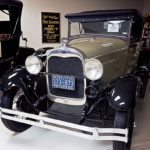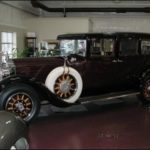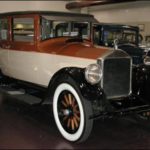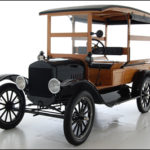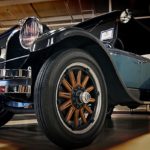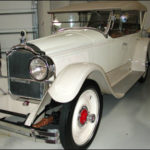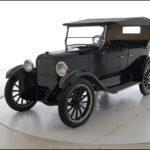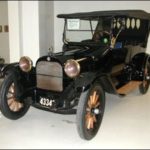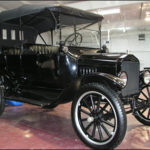Author Archives for adamgillrie
A sporty roadster with rumble seat.
After building millions of Model T's, Henry Ford shut down the Ford Motor Company in 1928, to re-tool for the all new and much heralded Model A. There was much excitement and anticipation. It seemed that everybody wanted to see the "New Ford."
The Model A was an uncomplicated four cylinder inexpensive machine, easy to own, easy to repair. From 1929 through 1931, it was America's number one seller This restored Ford Roadster was the model used by the noted artist Don Ensor, for his famous painting entitled "Fifty Cents Worth Please." Click Here for Audio Story
Over 70 years old, this is an original, unrestored Packard...original finish, original upholstery...original engine and power train. Documented mileage; 34,000.
SPECIFICATIONS:
384.8 Cubic Inch Straight 8 Engine
9 Main Bearings
143" Wheelbase
Road Clearance 8 3/4
Center Jump Seats
Weight: 5045 LBS
This car was the featured 1928 model Packard at the "Opus Magnum," the premier showing during the 100th anniversary celebration of the Packard Motor Company in Warren, Ohio, July 4 through July 9, 1999. Over 800 Packards, as well as Packard collectors from the world over, were there for this once a century event.
This great Packard 443 is an outstanding example of the fine car craftsmanship, engineering and attention to detail that was the trademark of luxury automobiles of earlier times. It is still sound and dependable and will cruise elegantly and comfortably at 45 to 55 miles per hour.
The 'Golden Age' of the Packard automobile occurred during the decades of the 1920's and 1930's. Preserved and restored Packards of this era are the true classics of today.
Click Here for Audio Story
Model 80 two-door trunk Sedan. 70 horsepower six-cylinder engine. 130-inch wheelbase. Updraft carburetor with vacuum tank. Notice the four wheel brakes; this was a brand new feature in 1925.
The pride of presidents and princes, the Pierce Arrow was one of the most envied and respected names in the history of American motoring. The Pierce Arrow was the car of choice of the rich and famous...and of every president from Woodrow Wilson to Franklin Delano Roosevelt.
In the mid 1920's, however, the Pierce Arrow policy of aiming only at the upper crust market was beginning to lose its potency. In an effort to reverse its sliding sales trend, the company brought out a lower price car, the Model 80 that you see here. This new Model 80 retained Pierce Arrow's distinctive headlights in the-fenders styling. It also featured a smooth, well engineered six-cylinder engine. The Model 80 for 1925 was a success in the marketplace.
This Model T Ford has a huckster wood body, a cargo carry all with many uses.
Many special use bodies were built for the Model T Ford.
Between 1909 and 1927 fifteen million Model T Fords were built. It was the car that retired the horse and put America on wheels. There was a time when half the cars sold in America were Model Ts.
"You can paint it any color, so long as it's black." It has never been proven that Henry Ford said this, but the phrase has survived for more than ninety years.
4 Cylinder Engine,
20 Horsepower,
Planetary 3 Band Transmission.
You are looking at a body off frame total restoration. The electric starter was an aftermarket accessory.
In 1924 a Model T Ford roadster could be purchased for as little as $395.
On the Model T floor board are three pedals. The left pedal is the "go pedal." The right pedal is the "stop pedal." The center pedal is the "back up pedal."
The Model T Ford was the first car for many Americans.
This was the beginning, the first year for Chrysler. This historic Chrysler was hidden away for many years before being discovered in 2005 by Bill and Carl Swope. It is indeed a rare and valuable icon.
Engine:
Inline L Head Six.
Cast Iron Block.
201 Cubic Inch Displacement.
7 Main Bearings.
68 Horsepower.
Technical:
112 Inch Wheelbase.
Manual Transmission.
Shaft Drive.
Four Wheel Hydraulic Brakes.
Wood Spoke Wheels.
The new Chrysler was introduced in January, 1924, at the New York Auto Show in the City's Commodore Hotel, a car introduction second in excitement only to that of the introduction of the Model A Ford. With its high compression engine, the new Chrysler had an amazing top speed of 75 miles per hour. Ralph DePama, the famous race car driver, used a Chrysler to win the Mt. Rushmore hill climb. He then drove the same care 1000 miles in just 17 hours.
The evolution of Chrysler represents one of the most stirring sagas in the history of the American Automobile. First, there was the fact that Walter P. Chrysler was able to start a brand new automobile company in the twenties and make it survive. But second, there were the amazing advances in engineering that w [...]
Clearly identified by its yoke-shaped radiator and its fluted hood, Packard was one of the great automotive names during the first half of the 20th century. Packard stood for fine engineering, long life, luxury and prestige. It was often the car of choice among up-scale buyers.
from 1899, when the first Packard was built in warren, Ohio, until the last one came off the line in 1958, the company produced 1,610,890 automobiles. During world war II, Packard built many of the rolls-merlin engines that powered our p51s and great Britain's spitfire fighter planes.
The 1923 Sport Touring on display here is one of the first Packard single sixes. The single six was introduced in 1922 as a successor to the cylinder twin six. At half the weight and at much lower cost than the twin six, the single six had almost the same horsepower, 56HP. The new in-line six engine was a beautiful example of quality engineering, with seven main bearings and 268.4 cubic inch displacement. Disc wheels, a low slanted windshield, vent wings, leather seats and a rear seat windscreen were distinguishing features of the Packard Sport Touring. The car was an overwhelming favorite among so-called "smart set" of the "Roaring Twenties."
This Packard was [...]
John and Horace Dodge were both machinists. When Henry Ford started the Ford Motor Company in 1903, the Dodge brothers machine shop built Ford's engines. As part of the deal, Henry Ford gave the Dodge brothers a one-tenth share in the Ford Motor Company, which the Dodge brothers later sold for $27,000,000 cash, the original capital for the Dodge Brothers Motor Company.
SPECIFICATIONS:
L head four cylinder engine.
25 hp pressurized vacuum tank fuel system.
12 volt Northeast electric starter/generator unit.
2 wheel brakes.
32X4 tires.
This 1922 model, Serial # 731464, has been in the Swope family since 1952. It is little changed from the original car produced by the Dodge brothers on November 14, 1914.
The Dodge Touring car got its first big test as a military vehicle in 1916 when General John J. Pershing took six Dodges on his punitive expedition into Mexico while pursuing the bandit chieftain, Pancho Villa. The success of the Dodge in the rugged wastelands of old Mexico soon was a matter of US Military History, and the Dodge became the US Army's first command car.
John and Horace Dodge were both machinists, when Henry Ford started the Ford Motor Company in 1903, the Dodge brothers machine shop built Ford's engines. As part of the deal Henry Ford gave the Dodge brothers a one-tenth share in the Ford Motor Company, which the Dodge brothers later sold for $27,000,000 cash, the original capital for the Dodge Brothers Motor Company.
SPECIFICATIONS:
L head four cylinder engine
25 hp pressurized vacuum tank fuel system
12 volt Northeast electric starter/generator unit
2 wheel brakes
32X4 tires
This 1922 model, Serial # 731464, has been in this Swope family since 1952. It is little changed from the original car produced by the Dodge brothers on November 14, 1914.
The Dodge Touring car got its first big test as a military vehicle in 1916 when General John J. Pershing took six Dodges on his punitive expedition into Mexico while pursuing the bandit chieftain, Pancho Villa. The success of the Dodge in the rugged wastelands of old Mexico soon was a matter of US Military History, and the Dodge became the US Army's first command car.
The Model T Ford was affectionately referred to as “The Tin Lizzie”.
Between 1909 and 1927, fifteen million Model T’s were built. It was the car that retired the horse and put America on wheels.
You can paint it any color, so long as it’s black. It has never been proven that Henry Ford said this, but the phrase has survived for more than seventy-five years.
4 Cylinder Engine
20 Horsepower
Planetary 3 Band Transmission
You are looking at a 1920 Model T touring car. It is a body off frame restoration. New interior, new top, new tires, new wiring, etc. It has electric starters, an after market accessory. The 1920 listed for $440.
On the floorboard were three pedals. The left pedal was the “go pedal”. The right pedal was the “stop pedal”. The center pedal was the “back up pedal”.
The Model T was the “first car” for many Americans.
